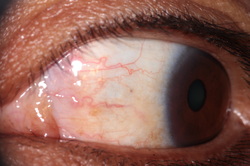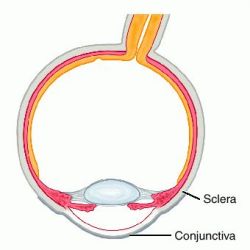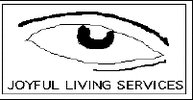
The red lines and other markings and colorings in the whites of the eyes actually correspond to real conditions within the body. Their size and shape and various other aspects of configuration and shading describe health qualities. Sclerology is therefore a means of looking into a person’s eyes to see what is happening with his/her health, to get a sense of what is most important, like exactly where the highest stress and congestion are located in the body, where such stress and congestion are coming from (originating cause), how much of the stress is emotional, how much physical, and how much both combined.
Sclerology is a way of viewing inherited tendencies to weakness, and of seeing various disease processes. It is a means of health evaluation that is accurate, its basics relatively easy to learn (although it has its degree of complexity), has important tissue information on systemic pathology, and can therefore be valuable to the healer/practitioner.
The sclerae show more than just the temporary conditions of redness that we commonly see from local eye irritation (as from squinting or other improper use of the eyes, smog or cigarette smoke, from getting something caught in the eye, or even from a local eye infection). Because it is continuous with the durra matter of the brain, the sclera is capable of showing conditions of health and disease in the body. As it turns out, the sclera shows a wide range of these conditions. When health is well, the sclera is a bright, crisp white color. When we are unhealthy, the sclera color changes accordingly, and such changes remain for whatever period of time (usually years) it takes to restore health - if indeed health is restored at all. In other words, we’re talking about chronic conditions, and we can see them coming via signs in the sclera years in advance of their appearance as symptoms.
The whites of the eyes show physical (purely sclera), emotional (purely conjunctiva), and combined physical and emotional/Oedipal (between sclera and conjunctiva) circumstances. Personality characteristics are not shown in the sclera, nor are etheric, psychic, or causal data, as seen in other Eyology maps. Name diseases, like “diabetes” and “cancer” and “arthritis” are not seen in the sclera. Instead, the actual tissue conditions are what is seen. Also seen is how these conditions developed, where they originated, if drugs were involved, and more, and, as noted above, usually long in advance of their appearance as symptoms.
The sclera proper shows physical circumstances only. Proper is a reference to the fact that when we look at the sclera we are actually looking at two maps in one. The sclera is overlain in its visible areas by a transparent membrane called the conjunctiva. The conjunctiva can also have lines in it - and almost always does in the case of adults, usually fewer in children. In fact, most of the lines we typically see in the whites of the eyes are actually conjunctiva lines, and not properly sclera lines at all. This fact reflects the essentially emotional nature of much of our pathology.
Sclerology Around the World
Many countries have a long tradition of using the sclera to evaluate health. The Chinese have used the sclera markings for at least 1000 years, quite possibly many more. Chinese medical texts dating from 1000 BP show drawings of the sclera with some sclera signs. The American Indians have a long history of sclera use, also. Dr. Stuart Wheelright, a Natural Health Practitioner who used Sclerology in the 1960’s ‘70’s and ‘80’s, apparently learned his first Sclerology from Nez Perce Indians and from Dr. Sundance Hathaway, a Blackfoot Indian. Medieval Europe knew Sclerology, as seen in drawings in medical manuals. In view of how easy it is in principle, it is hard for one to imagine why Sclerology would not be practiced more widely, especially by Natural Health Practitioners.
Structure of the Sclera
The “sclera” is the white, tough visible outer coating surrounding and protecting the eyeball. It is a strong, fibrous, opaque membrane covering 5/6ths of the eyeball. In the front of the eye the sclera is continuous with (or in some real sense becomes) the transparent cornea, which occupies the front 1/6th of the eyeball covering. Moving toward the back of the eye, the sclera becomes continuous with the durra matter of the brain. The six muscles that control the movement of the eyeball attach to the sclera, the other ends of which attach to the bony orbit we call the eye socket.

For more information on sclerology and for books and courses go to:
http://www.joyfullivingservices.com/sclerology.html


 RSS Feed
RSS Feed



